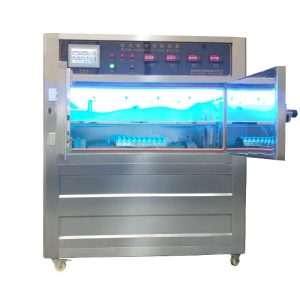Uv aging test chamber in solar photovoltaic weathering test
The application of UV aging test chamber in the field of photovoltaic (solar photovoltaic) is mainly used to evaluate the durability and weather resistance of solar photovoltaic materials and modules under long-term UV light. It can simulate solar radiation, temperature, humidity and other environmental conditions, and perform accelerated aging tests on photovoltaic materials and modules to evaluate their performance and life prediction in real outdoor environments.

Specific application
The following are some specific aspects of UV aging test chambers in photovoltaic applications:
Weatherability assessment of materials: Photovoltaic materials, such as silicon wafers, backplanes, and packaging adhesives, are affected by ultraviolet light, temperature changes, humidity and other factors when exposed to outdoor environments for a long time. The use of UV aging test chamber can simulate these external conditions, through the accelerated aging test, to evaluate the weather resistance and anti-aging performance of materials.
Module performance evaluation: Photovoltaic modules (PV panels) are the core parts of photovoltaic systems, and their performance and lifetime are crucial to the power generation efficiency and reliability of the system. Key indicators such as stability of photoelectric conversion efficiency, temperature characteristics, power attenuation and loss can be evaluated by long-term UV irradiation and environmental simulation of PV modules in a UV aging test chamber.
Material optical property test: The optical property of photovoltaic material is an important factor to determine its energy conversion efficiency. Uv aging test chamber can be used to test the optical properties of photovoltaic materials such as light transmittance, reflectivity and absorption rate, so as to evaluate the optical stability of materials under UV radiation and the change of photoelectric conversion efficiency.
Salt spray resistance evaluation: In some areas, salt spray in the Marine environment can cause corrosion and damage to the materials and components of PV systems. The UV aging test chamber can simulate the salt spray environment and conduct salt spray corrosion tests on photovoltaic materials and modules to evaluate their salt spray resistance and corrosion resistance.
Thermal resistance evaluation: PV modules need to be able to work stably in high temperature environments. By simulating the high temperature environment in the UV aging test chamber, the thermal aging test of photovoltaic modules can evaluate their performance indicators such as heat resistance, temperature coefficient and heat loss.
Uv aging test chamber in solar photovoltaic weathering test
Procedure of test
When using the UV aging test chamber for photovoltaic testing, the following steps can be followed:
Sample preparation: Prepare a certain number and size of PV material samples or PV module samples to ensure that they represent the materials and designs to be tested.
Set test parameters: according to the test requirements and standards, set the parameters of the UV aging test chamber, including the radiation intensity of the UV light source, temperature, humidity and test time. These parameters are adjusted according to the specific test criteria and the required test results.
Installation of samples: Install the PV samples in the test chamber to ensure that they are in the proper position and attitude. For PV modules, the installation should be carried out in accordance with the actual installation method, and ensure that the spacing and layout between samples are in line with the actual situation.
Start the test: start the UV aging test chamber and let the UV light source illuminate the sample. At the same time, the temperature and humidity in the test chamber are controlled to simulate the actual environmental conditions. Set the required test time according to the test requirements.
Monitoring and recording: Changes in the PV samples were monitored and recorded regularly during the test. This can include measurement of photoelectric conversion efficiency, measurement of current-voltage characteristic curves, observation of appearance, measurement of heat loss, etc. Professional test equipment and measurement tools can be used for accurate data recording.
Uv aging test chamber in solar photovoltaic weathering test
Analysis and evaluation: Based on the test results, the performance of the PV samples is analyzed and evaluated. Compare the data before and after the test to observe the change trend and the degree of performance loss. According to the purpose of the test, judge whether the sample’s weather resistance, photoelectric conversion efficiency stability, salt spray resistance and heat resistance meet the requirements.
Result report: A test report is generated based on the test results, describing in detail the testing process, the methodology and parameters employed, and the analysis and evaluation of the test results. The report can include pictures, charts, and data tables to visually show the results of the test.
The specific test methods and procedures may vary according to different standards, requirements and equipment. Therefore, before conducting the test, the relevant test standards and operation manuals should be carefully studied, and the operation should be carried out as required. In addition, in order to ensure the accuracy and reliability of test results, reasonable sample selection, sample installation and control of test conditions are also very important.
